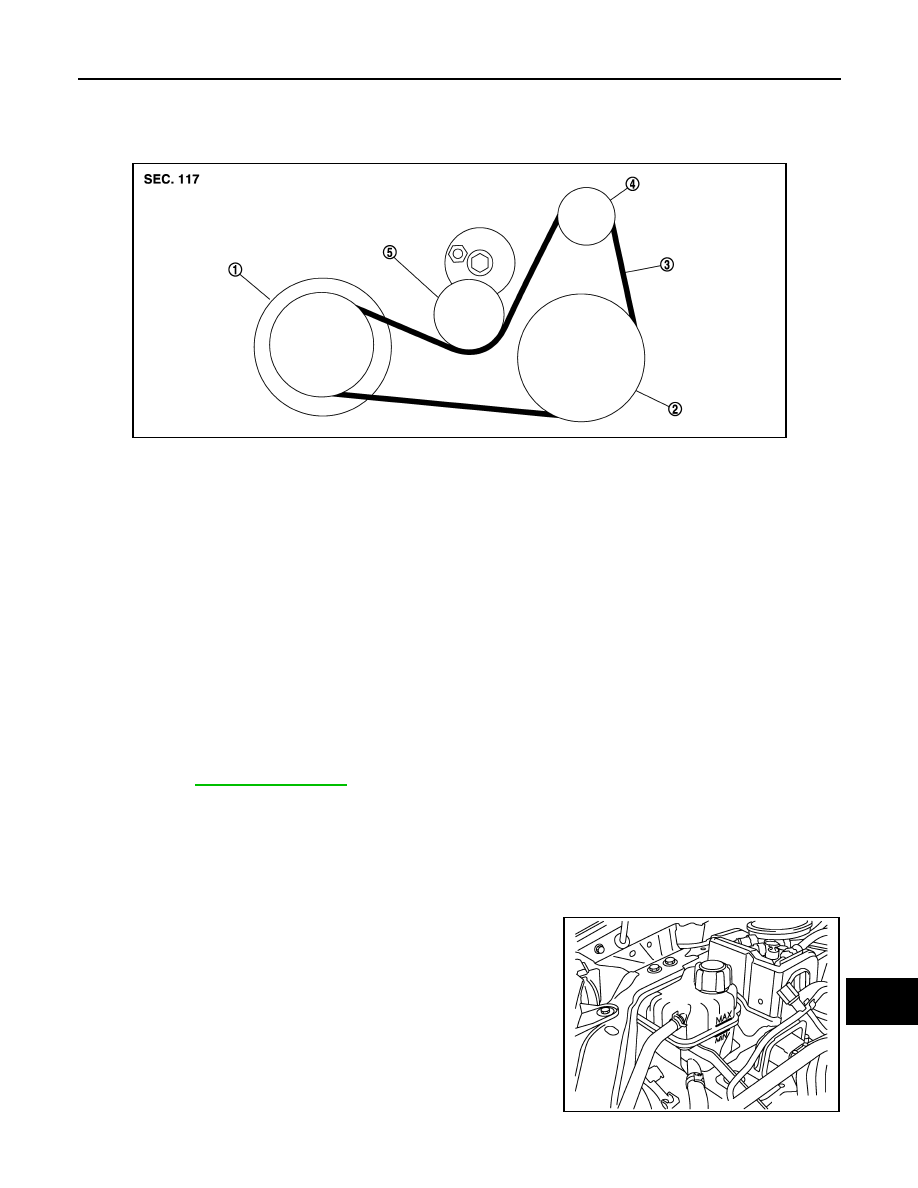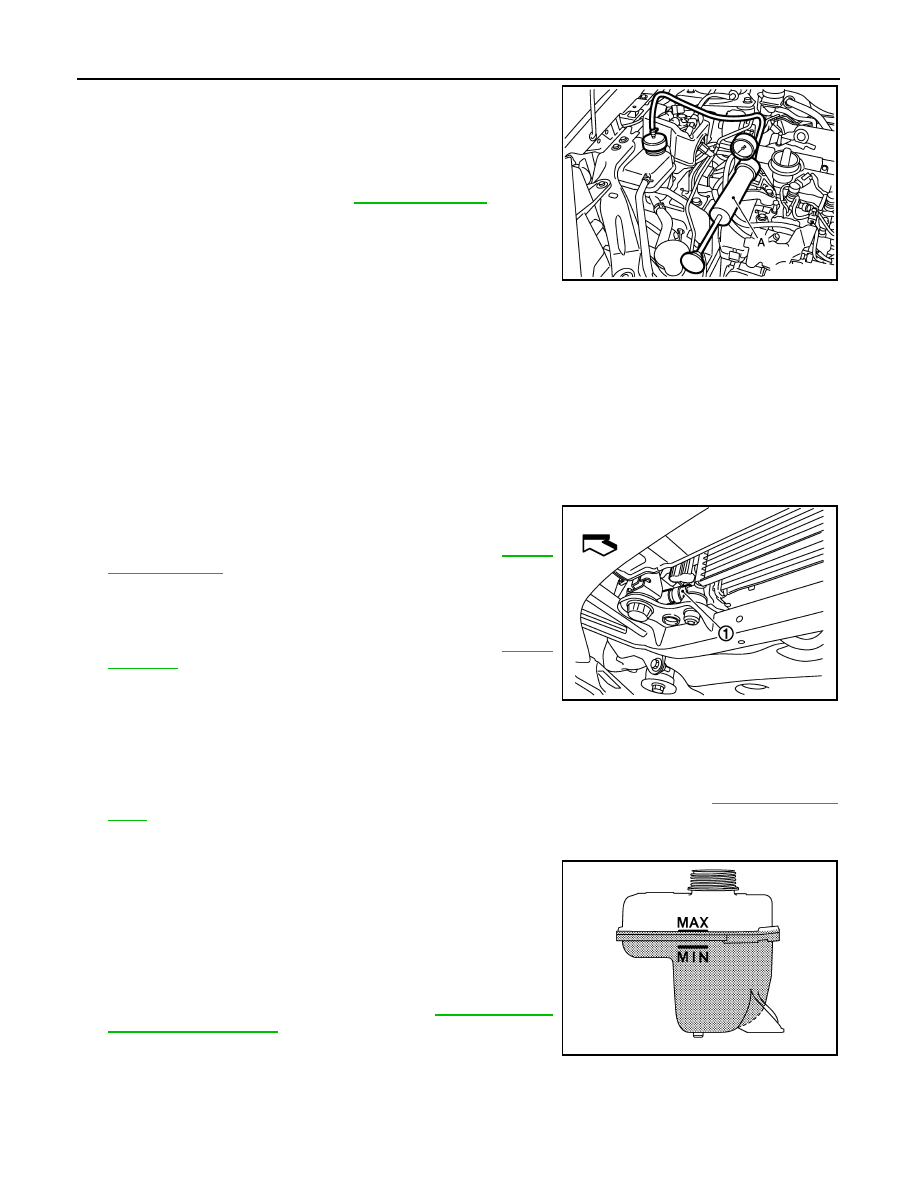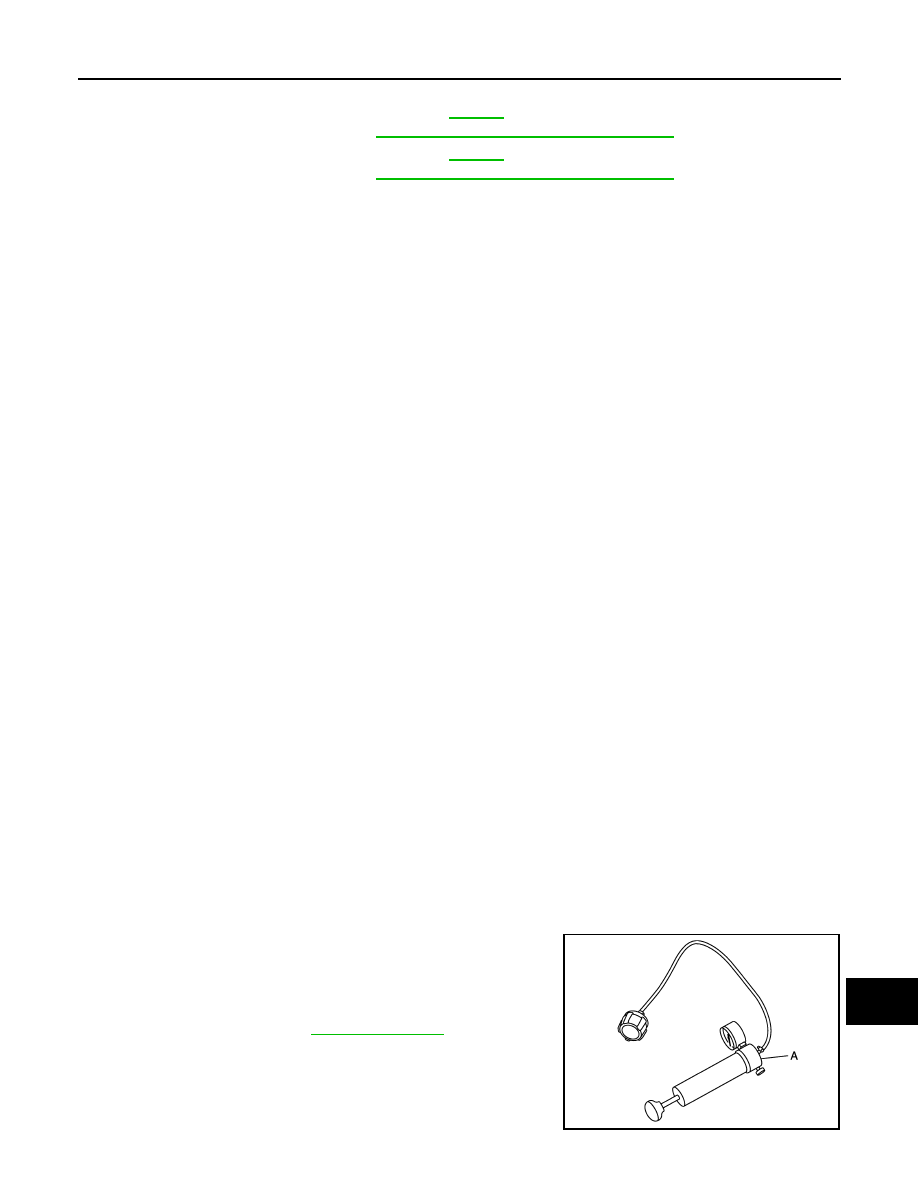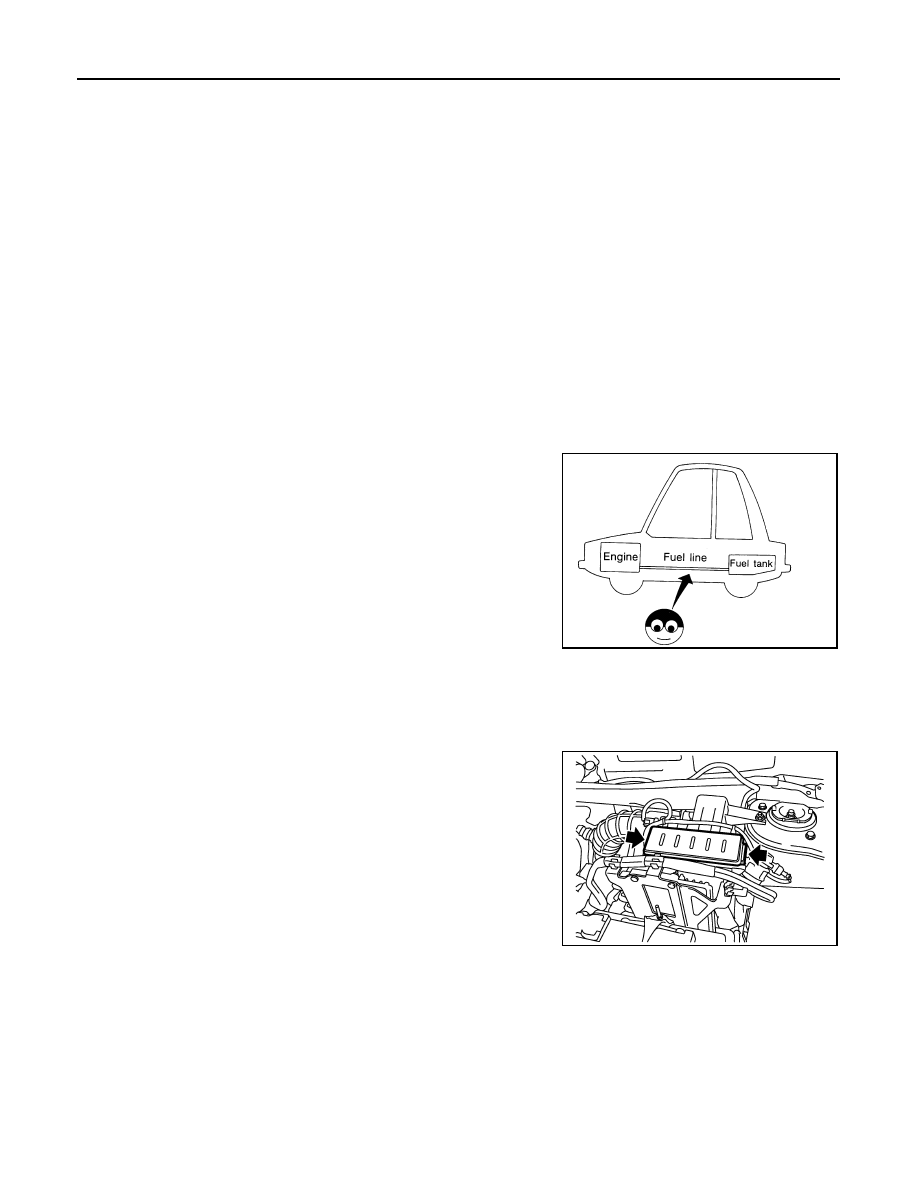Nissan Qashqai (2007-2010). Manual — part 2000

ENGINE MAINTENANCE (K9K)
MA-39
< ON-VEHICLE MAINTENANCE >
C
D
E
F
G
H
I
J
K
L
M
B
MA
N
O
A
ENGINE MAINTENANCE (K9K)
DRIVE BELTS
DRIVE BELTS : Exploded View
INFOID:0000000001116090
DRIVE BELTS : Inspection and Adjustment
INFOID:0000000001095677
INSPECTION
WARNING:
Be sure to perform when the engine is stopped.
1.
Inspect belts for cracks, fraying, wear and oil. If necessary, replace.
2.
Evaluate manually if the belt is enough tensioned (tension cannot be measured by way of frequency
meter).
3.
When drive belt is considered as not enough tensioned, replace it.
CAUTION:
Auto-tensioner must be replaced with a new one when the belt is replaced.
ADJUSTMENT
Belt tensioning is not necessary, as it is automatically adjusted by auto-tensioner.
ENGINE COOLANT
ENGINE COOLANT : Inspection
INFOID:0000000001095678
LEVEL
1.
Check if the reservoir tank coolant level is within MIN to MAX
when engine is cool.
2.
Adjust coolant if too much or too little.
LEAKAGE
E1BIA0021ZZ
1.
Crankshaft pulley
2.
A/C compressor
3.
Drive belt
4.
Alternator
5.
Drive belt auto-tensioner
.
E1BIA0035ZZ

MA-40
< ON-VEHICLE MAINTENANCE >
ENGINE MAINTENANCE (K9K)
• To check for leakage, fit the adapter to the reservoir tank, and then
connect it to the tester [SST: — (M.S. 554-07)] (A) as shown.
• Warm up the engine and turn it off.
• To check for leaks, apply pressure to the cooling system with the
radiator cap tester and radiator reservoir cap tester adapter.
• If the pressure drops, look for leakage.
• Unscrew slowly the adapter from the reservoir tank to reduce the
pressure in cooling system, and install the reservoir tank cap.
WARNING:
Never remove the radiator cap when the engine is hot. Serious burns could occur from high pressure
engine coolant escaping from the radiator.
CAUTION:
Higher pressure than specified may cause radiator damage.
ENGINE COOLANT : Draining
INFOID:0000000001095679
WARNING:
• To avoid being scalded, never change the coolant when the engine is hot.
• Wrap a thick cloth around cap and carefully remove the cap. First, turn the cap a quarter of a turn to
release built-up pressure. Then turn the cap all the way.
1.
Remove engine undercover.
2.
Disconnect reservoir tank hose (lower) (1) from radiator and
remove reservoir tank cap.
3.
Remove air relief plug from water outlet. Refer to
4.
Remove reservoir tank, then clean reservoir tank.
5.
Check drained coolant for contaminants such as rust, corrosion
or discoloration.
If contaminated, flush engine cooling system. Refer to
.
ENGINE COOLANT : Refilling
INFOID:0000000001095680
• Before start working, turn off the automatic air conditioner and the blower motor.
1.
Install reservoir tank, lower radiator hose and air relief plug.
2.
Fill reservoir tank slowly with coolant until coolant spills from the air relief hole. Refer to
.
• Put a cloth under the air relief plug to prevent engine coolant to dampen the crankshaft position
sensor.
• Pour coolant to the MAX level line of the reservoir tank at a
rate of 2 liter (1-3/4 lmp qt)/min or lower.
3.
Close the air relief plug.
CAUTION:
If the filling rate is too fast, this could lead to air being
mixed in the coolant. Be sure to fill the coolant slowly
according to the rate indicated above.
Use Nissan Genuine Coolant L250 or equivalent mixed with
water (distilled or demineralised). Refer to
Testing pressure
: Refer to
.
E1BIA0056ZZ
E1BIA0034ZZ
JPBIA0306ZZ

ENGINE MAINTENANCE (K9K)
MA-41
< ON-VEHICLE MAINTENANCE >
C
D
E
F
G
H
I
J
K
L
M
B
MA
N
O
A
4.
Start engine without closing reservoir tank cap and keep engine racing at 1,500 rpm for about 2-3 minutes.
If neccesary, pour engine coolant up to MAX level.
• If coolant overflows reservoir tank hole, install filler cap.
• Watch engine coolant temperature gauge so as not overheat the engine during all of the opera-
tion.
WARNING:
• Be careful not be scaled with hot engine coolant or vacuum pump when operating.
• Radiator fan blade can start at any time and make personal injuries.
5.
Turn off the engine and loose air relief plug until coolant spills from air relief hole.
6.
Close the air relief plug and run the engine at 2,000 rpm until the upper hose comes hot and radiator fan
operates. Let the engine running approximately 5 minutes at idle speed and check for sound of coolant
flow while running engine from idle up to 3,000 rpm.
• Sound may be noticeable at heater water cock.
7.
If sound is heard, bleed air from cooling system by repeating steps 4 to 6 until coolant lever no longer
drops.
• Check the radiator lower hose for any signs of leakage.
8.
Turn off the engine and let it cool down.
• Cool down using a fan to reduce the time.
9.
After cooling period, loose the air relief plug and check if coolant spills from the air relief hole. In other
case, remove the air relief plug until the coolant spills, and then close the relief air plug. Bleed air from
cooling system by repeating steps 6 to 10 until the coolant spills immediately.
10. Check the engine coolant level when engine is cool and refill to MAX level line if the level is lower.
• Clean excess coolant from engine.
11. Check that the reservoir tank cap is tightened.
ENGINE COOLANT : Flushing
INFOID:0000000001095681
1.
Fill reservoir tank with water until water spills from the air relief hole, then close air relief plug. Reinstall
reservoir tank cap.
2.
Run engine and warm it up to normal operating temperature.
3.
Rev engine two or three times under no-load.
4.
Stop engine and wait until it cools down.
5.
Drain water.
6.
Repeat steps 1 through 5 until clear water begins to drain from radiator.
7.
Blow compressed air into cooling circuit through the reservoir tank valve hole to drain all the water.
RADIATOR CAP
RADIATOR CAP : Inspection
INFOID:0000000001095682
• Fit the adapter to the tester as shown.
• When connecting the reservoir tank cap to the tester [SST: —
(M.S. 554-07)] (A), apply water or LLC to the cap seal part.
• Check reservoir tank cap relief pressure.
• Replace the reservoir tank cap if the engine coolant passes
through it, or if any fur signs is detected.
Engine coolant capacity
(With reservoir tank)
: Refer to
"Periodical Maintenance Specification"
Reservoir tank capacity
: Refer to
"Periodical Maintenance Specification"
Standard
: Refer to
.
E1BIA0057ZZ

MA-42
< ON-VEHICLE MAINTENANCE >
ENGINE MAINTENANCE (K9K)
RADIATOR
RADIATOR : Inspection
INFOID:0000000001095683
Check radiator for mud or clogging. If necessary, clean radiator as follows.
• Be careful not to bend or damage the radiator fins.
• When radiator is cleaned without removal, remove all surrounding parts such as radiator fan, radiator shroud
and horns. Then tape the harness and connectors to prevent water from entering.
1.
Apply water by hose to the back side of the radiator core vertically downwards.
2.
Apply water again to all radiator core surface once per minute.
3.
Stop washing if any stains no longer flow out from the radiator.
4.
Blow air into the back side of radiator core vertically downwards.
• Use compressed air lower than 490 kPa (4.9 bar 5 kg/cm
2
, 71psi) and keep distance more than 30 cm (11.8
in).
5.
Blow air again into all the radiator core surface once per minute until no water sprays out.
FUEL LINES
FUEL LINES : Inspection
INFOID:0000000001095719
Inspect fuel lines, filler cap and tank for improper attachment, leaks,
cracks, damage, loose connections, chafing or deterioration.
If necessary, repair or replace damaged parts.
AIR CLEANER FILTER
AIR CLEANER FILTER : Removal and Installation
INFOID:0000000001095684
REMOVAL
1.
Open air cleaner case.
SMA803A
E1BIA0036ZZ

Нет комментариевНе стесняйтесь поделиться с нами вашим ценным мнением.
Текст